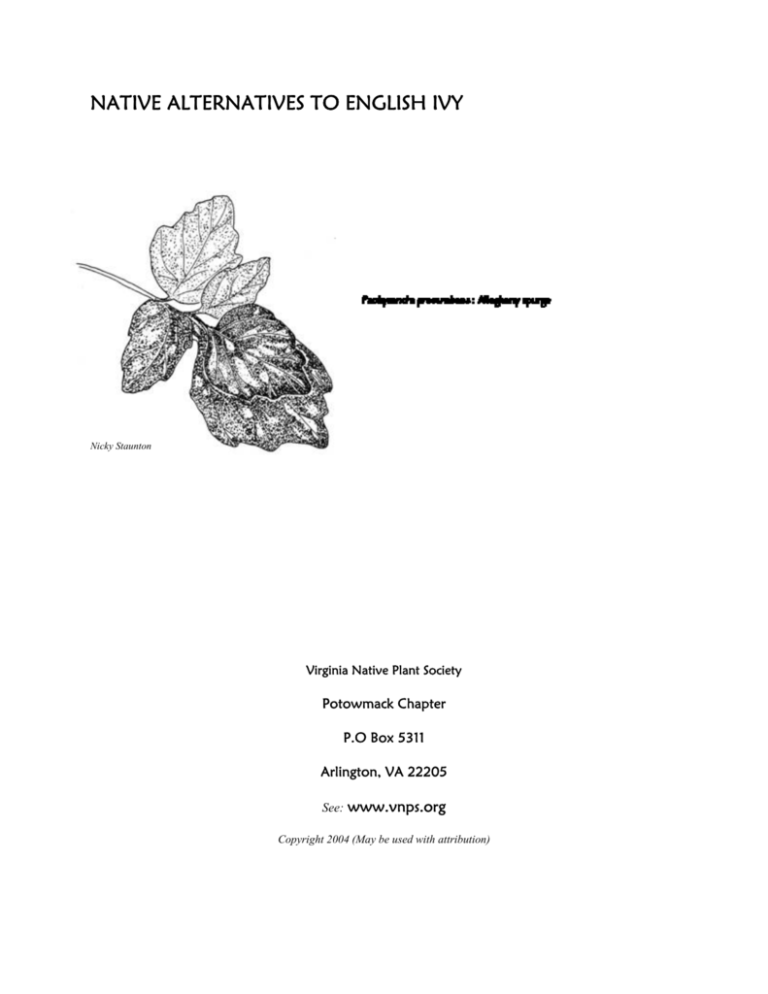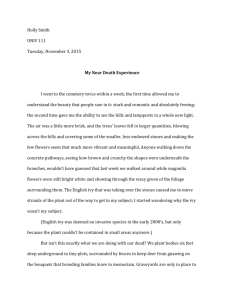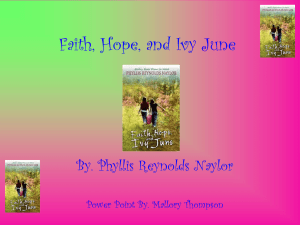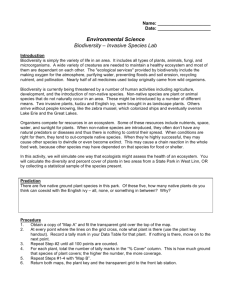native alternatives to english ivy
advertisement

NATIVE ALTERNATIVES TO ENGLISH IVY Nicky Staunton Virginia Native Plant Society Potowmack Chapter P.O Box 5311 Arlington, VA 22205 See: www.vnps.org Copyright 2004 (May be used with attribution) ALTERNATIVES TO ENGLISH IVY What do you do to replace English ivy? For many years homeowners in Northern Virginia have used English ivy (Hedera helix) in areas with landscaping challenges like dense shade or shady slopes. But over time, instead of solving problems, the ivy has created new problems, as it climbs up and chokes trees; it spreads to parks and other natural areas, where it destroys all native vegetation in its path; and it forms perfect hiding places for urban rats. Fortunately, many homeowners are now looking for alternatives to the ivy. The answer to what best replaces English ivy is not simple; it depends on its location, the conditions, and your landscaping goals. Do you want to re-create natural woodland? Are you trying to prevent erosion in one spot? Do you want your entire back yard to be a low maintenance garden with no grass? Do you want the area open or dense? Do you merely want to put in a little groundcover, which can withstand shade under a tree? Here are some ideas. GROUNDCOVER Evergreen or semi-evergreen for shade: -Creeping phlox (Phlox stolonifera) mats together to make a spectacular display of blue/violet in early spring and stays low and green throughout the rest of the year. -Green-and-gold (Chrysogonum virginianum) This plant hugs the ground and is evergreen in our area. It also creates lovely displays of yellow flowers in spring. -Allegheny spurge (Pachysandra procumbens) is an excellent groundcover for shade. -Virginia ginger (Hexastylis virginica) is a beautiful evergreen ground-hugger. -Golden ragwort (Senecio aureus) is evergreen and forms thick, spreading mats. In early spring it will send up tall stalks of yellow flowers, which pollinators love. When the spent flowers begin to look raggedy, cut them down to the leafy bases, which cover the ground. -Partridgeberry (Mitchella repens) hugs the ground. Chipmunks, birds, and squirrels eat its berries. It grows slowly. -Foamflower (Tiarella cordifolia) has frothy little spikes of white flower in May and the foliage lasts all year long. It will spread. Evergreen for semi-shade: -Robin’s plantain (Erigeron pulchellus) is a pale violet composite with a basal rosette. It blooms in spring and is very attractive to insects for its nectar. You can even walk on it. -Pussytoes (Antennaria plantaginifolia) is very low growing and dense with sprigs of pale green “toes.” -Mouse-eared coreopsis (Coreopsis auriculata) with yellow blooms attracts many butterflies and bees. -Wild stonecrop (Sedum ternatum), a succulent, will work with some sun. -Sedges (Carex spp.) Sedges form attractive clumps and colonize. Good choices are plantain-leafed sedge (Carex plantaginea), colonial oak sedge (Carex communis), and especially white bear sedge (Carex albursina). Deciduous for shade: -Wild ginger (Asarum canadense) is a lovely deep green and spreads in dense shade with moisture. It dies back after the first frost -Violets (Viola canadensis and other species) disappear in winter, but they provide nectar in early spring and are hosts to several butterfly larvae. Ants will spread the seed around. Vines: -Virginia creeper (Parthenocissus quinquefolia) is taller and less dense than English ivy, but looks beautiful under trees. It will grow up trees without harming them because it is deciduous. Birds love the berries. It is aggressive, so be sure to put it in a place that you don’t mind it spreading. -Crossvine (Bignonia capreolata), yellow jessamine (Gelsemium sempervirens) and native honeysuckle (Lonicera sempervirens) are not invasive, and they are all sources of nectar for pollinators and hummingbirds. The red berries of the native honeysuckle feed birds, squirrels, and chipmunks. HERBACEOUS PLANTS The following are plants that spread on their own to cover a shady/semi-shady area where there was once ivy: -Virginia knotweed (Tovara virginiana/Persicaria virginiana) will completely fill a large space in a couple of years and looks very nice in a “shaggy, woodsy way.” In addition to the straight species there is a colorful cultivar with variegated leaves, tiny red flowers and seedheads, called ‘Painter’s Palette.’ Cardinals and other birds love the seed of knotweed. -White wood aster (Eurybia divaricata, formerly Aster divaricatus) will take over a shady area and provide nectar for pollinators in fall. Cut back the spent blooms and enjoy its semi-evergreen leaves. -Heart-leafed aster (Symphyotrichum cordifolium, formerly Aster cordifolius) is similar to white wood aster, but with pale blue flowers. -Lobelia species (Lobelia cardinalis, Lobelia siphilitica) have basil rosettes that will spread. They even take sun in areas that stay moist. -Zigzag goldenrod (Solidago flexicaulis) is very attractive to pollinators in fall. -Wreath goldenrod (Solidago caesia) also will spread into a lovely mounded shape. -Turtlehead (Chelone glabra) in both the white and pink form will spread in moister soils, and the hummingbirds and bumblebees love its nectar. Ferns: - For an attractive, taller groundcover, The following ferns will spread if the area is reasonably moist: hay-scented, New York, sensitive and lady ferns. Christmas fern is an evergreen alternative that will not spread and will grow on slopes. A NATURAL WOODLAND If a property has tall trees and is near a wooded natural area, you may consider letting the backyard blend in with the woodland. In that case, after pulling out the ivy, you can leave things alone and let nature do the work. Leaf litter can remain. Seeds may be lying dormant in the soil. For example in our area, Solomon’s seal (Polygonatum biflorum), jack-in the pulpit (Arisaemia triphyllum) , bloodroot (Sanguinaria canadensis), trout lily (Erythronium americanum), spring beauty (Claytonia virginica), or mayapple (Podophyllum peltatum) could appear, as well as numerous woody shrubs. Be careful to remove invasives, such as porcelain berry, multiflora rose, or bush honeysuckle, which can be planted by birds. A PLANTED WOODLAND GARDEN If you simply can’t resist all the wonderful natives or want to enhance habitat for birds and pollinators, you can create a woodland garden under trees. A simple, low maintenance approach, if you have tall canopy trees would be to add only understory trees and shrubs, such as dogwood (Cornus florida), persimmon (Diospyros virginiana), chokeberries (Aronia spp.), and several species of viburnums (Virburnum spp.). Ideally, choose those trees and shrubs, which would have occurred naturally in the original ecosystem. For a more open look, reduce the number of shrubs and add some of the native groundcovers listed before: green and gold, native ginger, creeping phlox, golden ragwort, pachysandra and foamflower. Or fill in the woodland with a diversity of other native plants including several species of ferns, Virginia bluebells (Mertensia virginica), bloodroot (Sanguinaria canadensis), Jacobs ladder (Polemonium reptans), violets (Viola spp.), jack-in the pulpit (Arisaemia triphyllum), wood poppy (Styloforum diphyllum), wild blue phlox (Phlox divaricata), wild bleeding heart (Dicentra eximia), wild geranium (Geranium maculatum), wild columbine (Aquilegia canadensis), solomon’s seal (Polygonatum biflorum), may apple (Podophyllum peltatum), false solomon’s seal (Smilacina racemosa), black snakeroot (Cimicifuga racemosa.), white snakeroot (Eupatorium rugosum), mistflower (Eupatorium coelestinum) white wood aster (Aster divaricatus), heart-leafed aster (Aster cordifolius), turtlehead (Chelone glabra), Canada anemone (Anemone canadensis), alumroot (Heuchera americana) rue anemone (Thalictrum thalictroides), goatsbeard (Aruncus dioicus), and more. For a list of native plants for landscaping in Virginia see: http://www.dcr.state.va.us/dnh/native.htm PREVENTING EROSION Use many species in concert to prevent erosion. We recommend fragrant sumac (Rhus aromatica), whorled milkweed (Asclepias verticillata), colony-forming native honeysuckle shrub (Diervilla lonicera), and red and black chokeberries (Aronia spp.). The latter tolerate widely varying conditions. According to the Virginia Department of Forestry (VDOF), one of the best ways to prevent erosion on a steep slope is to plant trees. The network of roots holds the soil better than anything else. For recommendations on species of trees to plant particularly along a stream, see the plant guide for riparian reforestation, compiled by VDOF: www.vdof.org/rfb/riparian/rwg/genbuff/smallt.pdf. This list shows light requirements and planting zones from flood plains to upper slopes. It also recommends small tree and shrub species, which may work well where there are overhanging wires. Tree seedlings are available from VDOF and the Northern Virginia Soil and Water Conservation District. On a slope with some sun, we recommend other sumacs (Rhus spp.) and coral berry (Symphoricarpus orbiculata), which grow fast and spread. Pussytoes (Antennaria spp) will help stabilize a dry bank. Warm season native grasses with deep roots are also excellent on a dry slope. Use river oats (Chasmanthium latifolium) in a shadier area. Intersperse these plants with tree seedlings. WHERE TO BEGIN? We recommend that you start out doing a little at a time. (See Arlington County’s brochure on “Controlling English Ivy.”) Pull the ivy out from under a couple of trees and connect the trees with an island of leaf mulch no more than two inches thick. Then either let the island alone to see what natives come up, or plant native shrubs or herbaceous native plants in the island. Please remember never to dig out native plants from parks or other natural areas. Over time, by removing the ivy and planting beds or letting nature take its course, you can turn your entire backyard into a more natural area. Use narrow paths made of wood chips. You will marvel at the diversity of birds, butterflies, bees, beneficial insects, rabbits, toads, spiders, shrews, snakes, possums, foxes, and chipmunks as they begin to gather. Compare that view with the bleak landscape of English ivy!







